Begin the "Define" section by reflecting on what you know and want to know about this "Thing."
Protection of intellectual property is not only a law, it is a civic duty. As an educator you need to promote the Legal and Fair use of this property just as you would a student’s backpack or electronic device. As teachers you also have to model good digital citizenship. This is why this "Thing" is dedicated to helping you learn about copyright, fair use, Creative Commons and the TEACH Act of 2002, so that you can use them correctly and teach them to your students.
Learning Objectives
Click on each title below to see detailed information.
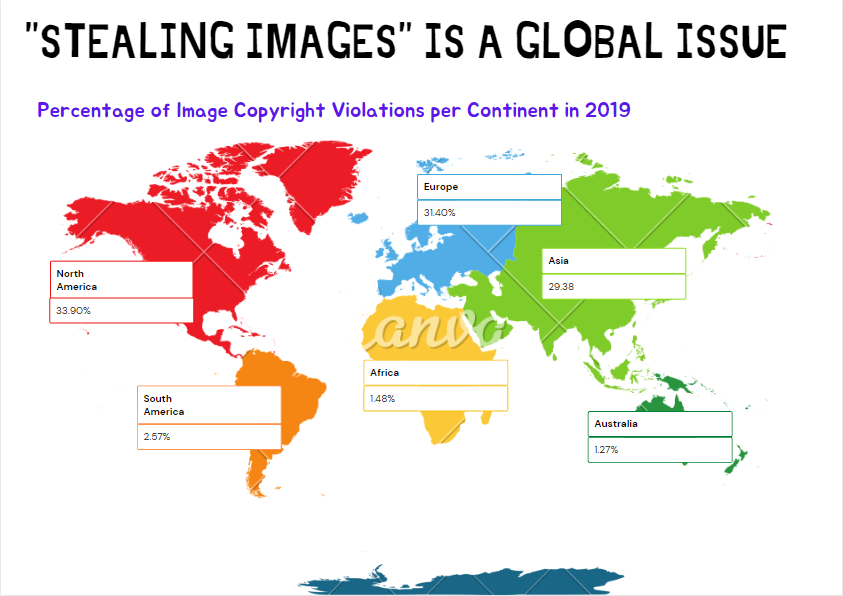
For information regarding the data source for this infographic, go to “Global Infringement Report © 2019 Copytrack GmbH” .
Attribution: Image created using Canva by Deborah Potter, Public Domain
As this graphic indicates, the United States is the leader in copyright violations for online images. Basically, when someone uses an image created by someone else without their permission, they are breaking the law. Without using legal terminology, this is called stealing someone’s intellectual property. So what qualifies as intellectual property? Anything that someone creates. The creation then becomes the intellectual property of the original creator who then has the rights to the first methods or means of use. Specific examples of intellectual property that might be utilized by teachers are, but not limited to, IMAGES, videos, essays, worksheets, slide decks, quizzes, books, movies and posters.
In order to protect intellectual property, laws were created. Here are some brief descriptions of these laws in the United States:
Copyright Law: protects the rights of any creator of content by giving them the legal power to do with their works as they choose. The owner then has exclusive rights to sell, make copies, derive other works from it, or place it on public display. Copyright Law, as it currently stands, is covered in Title 17 of the United States Code.
Fair Use: are guidelines that allow educators to use copyrighted materials. In general, teachers apply what is called Fair Use to much of the materials and content used in their classrooms. To further understand Fair Use, please take a look at Stanford University’s Copyright and Fair Use web page.
TEACH Act of 2002: The Technology, Education And Copyright Harmonization (TEACH) Act of 2002 attempts to remedy the many inconsistencies in the 1978 Copyright Law regarding teaching and learning in online or blended situations. This act is a supplement to Fair Use and applies to the digital content of your class. Watch this video about the TEACH Act or read Frequently Asked Questions from the American Library Association to learn more.
In order for teachers to understand how to comply with these laws and teach their students about them, they will also have to understand the following:
Open Educational Resources: OERs are any type of teaching, learning or research material that exists in the public domain or is published under open licenses (i.e. Creative Commons). They are free and can include textbooks, lecture notes, syllabi, assignments and tests.
Public Domain: applies to creative materials that are not protected by intellectual property laws. The public owns these works, therefore anyone can use a public domain material without obtaining permission, but no one can ever own it. Beethoven’s 5th, DaVinci’s Mona Lisa, Poe’s The Raven and generally anything created before 1920 are all examples of public domain materials.
Creative Commons: CC has developed a system that acknowledges the creator and his/her intentions for using the material. CC licenses specify how OER materials (those not in the public domain) can be used, reused, adapted, shared and modified. For more information about their collaborative global efforts, visit the Creative Commons website.
Plagiarism: occurs when someone copies another person's intellectual property and passes it off as their own. This is illegal, and the owner of the intellectual property can sue a plagiarizer in federal court for copyright violation.
Since we are not lawyers, for this Thing, let us just focus on how you and your students can comply with these laws when using images, written words, spoken words, videos and music.
Pre-Assessment
Like best practice indicates, let us begin with a pre-assessment of your Copyright IQ. Please take this quiz. (To see the correct answers, be sure to click submit.) Based on your results, what do you still need to know in order to legally and fairly use materials in your lessons?
To help you answer this question and assist you with strengthening your understanding of these issues, we will use this scenario throughout the Define section of this Thing.
Scenario: Imagine that you want to teach about empathy by showing your students an entire episode of Disney’s Mandalorian. You pay for the streaming service, but you are not sure if you can legally use this material for the lesson.
This diagram will guide our discussion as we answer the question about showing this streaming video. Each element in this flow chart is defined separately in the sections below.
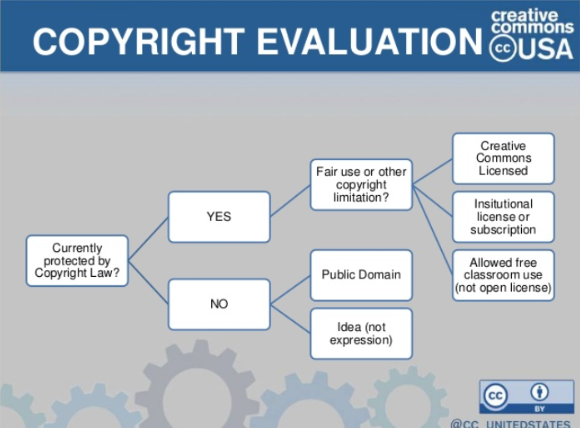
Graphic by: Meredith Jacobs, Assistant Director, PIJIP at American University Washington College of Law
STOP & THINK
How could you use the Copyright IQ quiz or the above infographic with with your students to start the conversation about these topics?
![]()
Now that you have a better understanding of the laws and your current knowledge, move on to the next section - Currently Protected by Copyright Law?
Is the Material Currently Protected by Copyright Law?
Any material you could use in your classroom that is not found in the public domain will be protected by Copyright Law.
If you use someone else’s creation in a manner that was not intended by the creator, then you are in violation of this law. In order to be in compliance, a person must have written permission from the creator to use the copyrighted piece of “work.”
The type of original content protected by the Copyright Law includes literary, dramatic, musical, artistic, and certain intellectual works. It can also include assignments and materials you create for your classes or even the notes your students take in class.
For more clarification, watch/listen to this video called Copyright Basics for Teachers. (select image below to start)
Based on this information, Disney’s Mandalorian streaming video would be protected by Copyright Law. This means we have to consider the upper pathway on the Copyright Evaluation flowchart. In other words, do we need to get written permission to show it in our face-to-face or online class?
STOP & THINK
Make a list of all the videos you utilize in the classroom and determine if they are Copyright protected.
![]()
Now that you have an understanding of Copyrighted material, move on to the next section - Fair Use Limitations of Copyrighted Material.
If the Material is Copyrighted, What Are the Fair Use Limitations?
Fair Use is an exception to Copyright Law. It allows for using a portion of a copyrighted material for purposes that are limited and transformative, such as to comment upon, criticize, or parody the work. Such uses can be done without permission from the copyright owner and would not be considered an illegal infringement.
How do you know if the material is covered by Fair Use?
It has to pass the The 4 Factor Test as visualized in these 2 graphics:
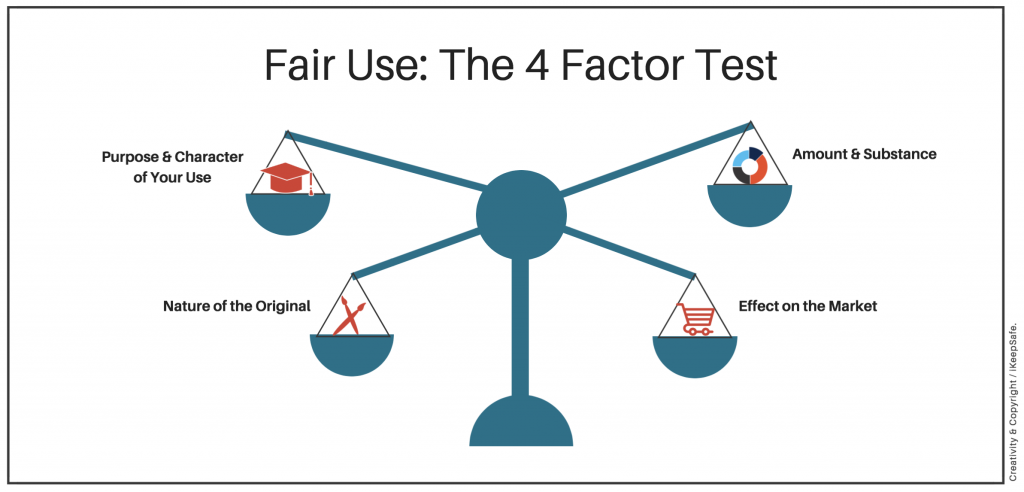
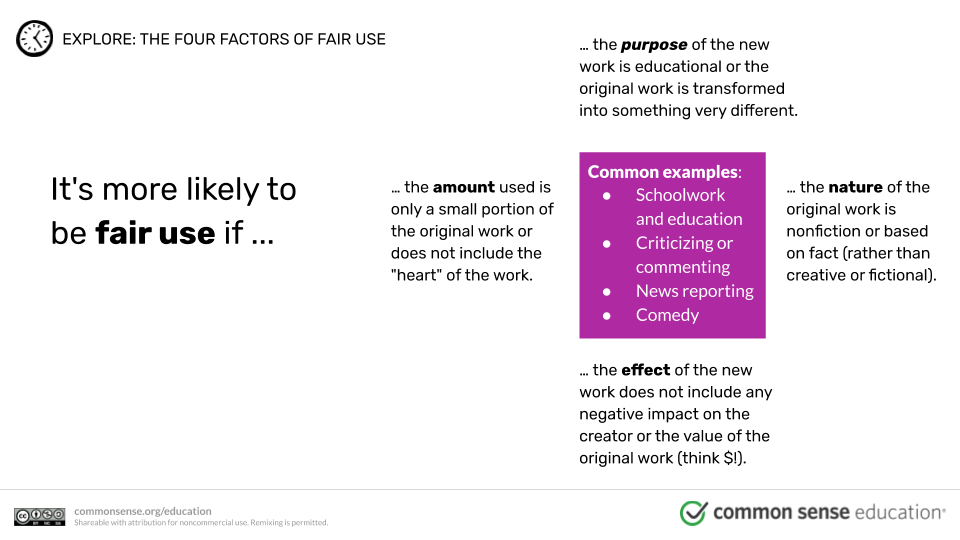
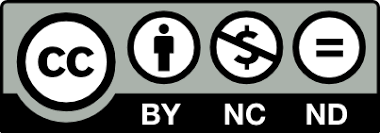 From The Educator's Guide to Creativity & Copyright by Kerry Gallagher, Larry Magid & David Sohn. Available at ConnectSafely.org/Copyright and Common Sense Education.
From The Educator's Guide to Creativity & Copyright by Kerry Gallagher, Larry Magid & David Sohn. Available at ConnectSafely.org/Copyright and Common Sense Education.
For specific examples of determining Fair Use in the classroom, make a copy or download the Copyright and Fair Use Guidelines for Teachers Graphic.
If the graphic can not help you answer the question, then you can also ask yourself these questions to determine if the material falls under Fair Use. These are the same four factors that judges use to determine Copyright Infringement.
Factor 1: What is the purpose and character of using the material?
- Does the new work transform the original work or offer something beyond the original? Copyrighted works that are altered significantly are more likely to be considered fair use.
- Is the use for nonprofit or educational purposes? Copyrighted works used for nonprofit or educational purposes are more likely to be considered fair use.
- Our Scenario: The Mandalorian video will be used for educational purposes to teach the empathy objective. Fair Use 👍
Factor 2: What is the nature of the copyrighted work?
- Is the copyrighted work published or unpublished? Published works are more likely to be considered fair use.
- Is the original work out of print or in publication/circulation? Out of print works are more likely to be considered fair use.
- Is the copyrighted work factual or creative? Factual works (non-fiction) are more likely to be considered fair use.
- Our Scenario: The Mandalorian video is published, in publication, and is fictional. Not Fair Use 👎
Factor 3: Is the amount of the original work used reasonable?
- The smaller the percentage of the work used, the more likely it is to qualify as fair use. For example, using 2 pages from a book that is several hundred pages is likely to be considered fair. However, using 2 pages from a six-page publication could be considered copyright infringement. Along the same lines, using 20 seconds of a two hour video would be considered fair use, but using 20 seconds from a one minute video would not.
- Is the section of the original work the most important part of the work? The less significant the portion of the work used, the more likely it is to be considered fair use.
- Our Scenario: Playing the entire episode of the Mandalorian streaming video - Fair Use 👎
Playing only portions of the video related to empathy - Fair Use 👍
Factor 4: What is the amount and substantiality of the portion taken?
- What is the effect of the use upon the potential market. How does using the material financially impact the creator?
- Does the new use appeal to the same audience as the original work? Copyrighted works that are used for another purpose or designed to appeal to a different audience are more likely to be considered fair use.
- Our Scenario: You have paid the Disney streaming fee and students will be watching for education and not entertainment purposes. Fair Use 👍
From the criteria on the chart and these 4 questions,using the Mandalorian streaming video gets 3 thumb’s up and 2 down. Based on these results, it is still unclear if showing the video would be considered Fair Use.
Luckily there is another method for determining Fair Use: complete the Fair Use Checklist by Kenneth D. Crews (Director of Columbia University Libraries) or the University of Chicago’s online version. By filling out the checklist, you can visually see if the number of check marks favors or opposes Fair Use, AND you will have a record of your intent to determine Fair Use.
We put our Mandolarian streaming video example through the checklist and found 8 to 5 in favor of Fair Use. Therefore, showing the entire video for the empathy lesson would be considered Fair Use.
STOP & THINK
Watch this lighthearted video called A Fair(y) Use Tale created by Professor Eric Faden of Bucknell University (CC-BY). As you watch, you will understand why we did not have to pay Disney for the rights to showcase it here.
![]()
Now that you have an understanding of Fair Use, move on to the next section - Creative Commons Licenses - How to Use and Create.
Creative Commons Licenses: Method for Using Online Content in Your Blended Classroom
While most materials a teacher uses in their face-to-face classroom will be Fair Use, the content they capture and use from the internet or post on their class “web page” is not.
This is why the TEACH Act was created. Basically Fair Use covers compliance to Copyright Law, while the TEACH Act governs how to download, use and share digital content legally. (Source: TEACH Act Law and Legal Definition | USLegal, Inc.)
In order to be a good digital citizen and comply with the TEACH Act, you have to understand the permissions you need for using and sharing that image/song/worksheet/video you got off of the internet or other virtual source. Fortunately, there is an easy system for determining the usage permissions and for giving attribution to the creator. It is called Creative Commons Licensing (CC).
This image shows the most current icons for all of the 4.0 International CC Licenses.
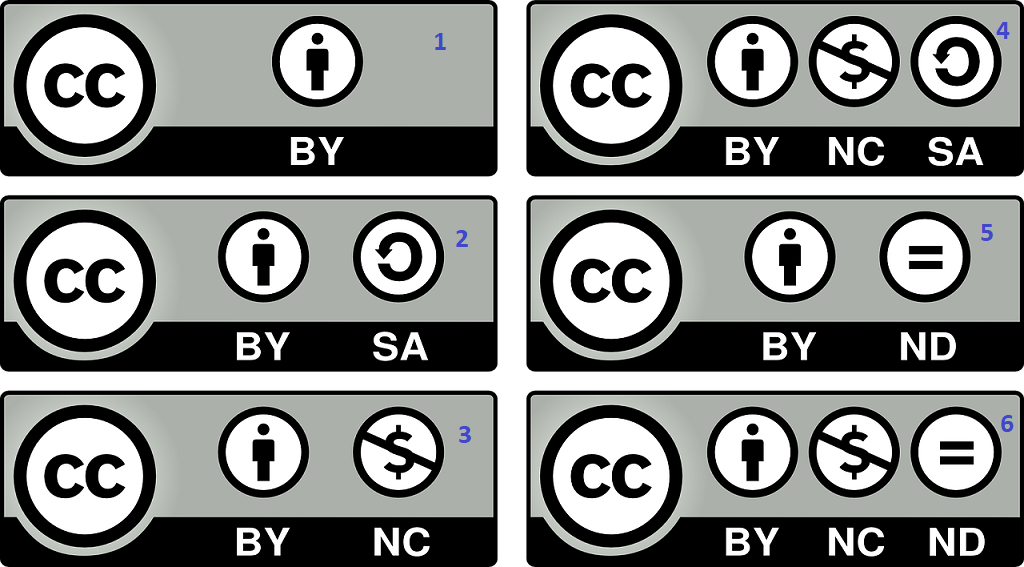
Attribution: Deborah Potter, CC BY
CC License Icons Defined:
1: Attribution: credit the “author”
2. Attribution, Share Alike: credit the “author” and use it only as it was originally intended
3: Attribution, Non-Commercial: credit the “author” and can not profit from use
4: Attribution, Non-Commercial, Share Alike: credit the “author”, no profit, share with the same license as the original
5: Attribution, No Derivative: credit the “author” and do not change or create a derivative of it
6. Attribution, Non-Commercial, No Derivative: credit the “author”, no profit, do not change
This image was created by Progressor from Pixabay, but we added the numbers. How should we acknowledge that this is not our creation? We can include their name and add a CC License under the image.
To do this, we used the CC Licence Chooser license creator.
Here is the CC license for this image based on the information from Pixaby and the CC License Chooser.
Furthermore, because this item did not have a ND component, we were allowed to add the numbers.
To make things even easier when choosing a material for the online component of your lesson, you can search for teaching materials that have a particular CC License. To do so, use the CC Search Browser Extension.
For more information about CC licensing, watch these videos from Brick Press and University of Guelph (geared toward younger audiences).
STOP & THINK
Using the CC License Chooser, create a CC license for something you have created like a slideshow presentation or worksheet.
![]()
Now that you have an understanding of Creative Commons Licensing, move on to the next section - OERs & Post-Assessment.
Due to the internet, teachers have a wide range of materials to choose from when designing a lesson. Another source is Open Educational Resources (OERs).
OERs contain 5 privileges: to retain, reuse, revise, remix and redistribute. Keep in mind that just because an online material is an OER, it does not mean you can forget about the Copyright Law. For a better understanding of how Copyright, OERs and Creative Commons all come together, view this slide deck from Meredith Jacobs.
A great place to start when looking for OERs is OER Commons.
Lastly, when in doubt, write to the creator to ask his/her permission. A simple email will do.
In summary, it is the teacher’s responsibility to model good digital citizenship. At a minimum, this means that when using non-Fair Use materials, you should respect the CC license and utilize the item based on it. Furthermore, you should be creating a CC license for every piece of work that you create for your class.
In an effort to model best practices, we would like you to retake the Copyright IQ Quiz to self-assess your growth on the Be Legal & Fair information.
![]()
Now that you have investigated OERs and taken the post-test, move on to the next section - Plagiarism.
Plagiarism
Besides images, the written word is very easy to just copy/paste from the internet. Since this tech short-cut is utilized everyday, most students do not even realize that they are “stealing” someone’s intellectual property. And with 1000s of resources, a teacher can not be expected to know which ones have been plagiarized. Fortunately there are tech tools to help teachers check if something is authentic or not. Even better, these resources are also useful for students to evaluate their own writing.
Here are two Plagiarism Checkers - give them a try.
To understand the difference between Copyright Infringement and Plagiarism, view this Macomb Academy for Digital Educators presentation slide deck by Courtney Conley.
This is the last section of "Thing" 9's Define playlist. Now would be a great time to revisit your Reflection Document and think about what you learned in this "Thing." Capture a screenshot of your results from the Knowledge Check and post them in your Reflection Document. As you move forward, consider the following: How might you use this in your own professional practice? What goals might you set for yourself, including activities, timelines, and evaluation? What connections did you make to the ISTE Standards or your own content area standards? How will you monitor your own progress towards these goals? Then proceed to the next section.